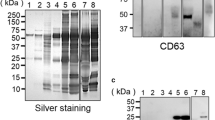Abstract
The goals of this study were to determine thesteroid-binding specificity of the mouse salivaryandrogen-binding protein (ABP) family and to ascertainwhether there might be other proteins in mouse saliva capable of binding steroids. The optimalconditions for testosterone binding by mouse salivaryproteins were determined using a small-scalechromatography system to separate bound from unboundsteroid. Testosterone binding appeared to be biphasicbut was directly proportional to saliva concentration,with an optimum temperature of 37 C in the second phase.These results were used to develop a steroid-binding protocol to study the steroid specificity ofsalivary proteins separated by electrophoresis. The ABPfamily bound testosterone and progesterone well andHO-progesterone and DHT to a lesser extent but did not bind either cholesterol or estradiol.Steroid structural comparisons suggest that binding byABP is governed by the A ring of the steroid. Anotherprotein that is not a member of the ABP family bound cholesterol specifically but no protein thatspecifically bound estradiol was observed.
Similar content being viewed by others
REFERENCES
Beato, M., and Baier, R. (1975). Binding of progesterone to the proteins of the uterine luminal fluid. Identification of uteroglobin as the binding protein. Biochim. Biophys. Acta 392:346.
Booth, W. D., and White, C. A. (1988). The isolation, purification and some properties of pheromaxein, the pheromonal steroid-binding protein, in porcine submaxillary glands and saliva. J. Endocr. 118:47.
Coyne, J. A., and Charlesworth, B. (1997). Genetics of a pheromonal difference affecting sexual isolation between Drosophila mauritiana and D. sechellia. Genetics 145:1015.
Dlouhy, S. R., and Karn, R. C. (1983). The tissue source and cellular control of the apparent size of androgen binding protein (Abp), a mouse salivary protein whose electrophoretic mobility is under the control of Sex-limited saliva pattern (Ssp). Biochem. Genet. 21:1057.
Dlouhy, S. R., and Karn, R. C. (1984). Multiple gene action determining a mouse salivary protein phenotype: Identification of the structural gene for androgen binding protein (Abp). Biochem. Genet. 22:657.
Dlouhy, S. R., Nichols, W. C., and Karn, R. C. (1986). Production of an antibody to mouse salivary androgen binding protein (ABP) and its use in identifying a prostate protein produced by a gene distinct from Abp. Biochem. Genet. 24:443.
Dlouhy, S. R., Taylor, B. A., and Karn, R. C. (1987). The genes for mouse salivary androgen-binding protein (ABP) subunits alpha and gamma are located on chromosome 7. Genetics 115:535.
Dominguez, P. (1995). Cloning of a Syrian hamster cDNA related to sexual dimorphism: Establishment of a new family of proteins. FEBS Lett. 376:257.
Ferkin, M. H., Sorokin, E. S., Renfroe, M. W., and Johnston, R. E. (1994). Attractiveness of male odors to females varies directly with plasma testosterone concentration in meadow voles. Physiol. Behav. 55:347.
Heyns, W., and de Moor, P. (1977). Prostatic binding protein. Eur. J. Biochem. 78:221.
Hwang, J. H., Hofstetter, J. R., Bonhomme, F., and Karn, R. C. (1997). The microevolution of mouse salivary androgen-binding protein (ABP) paralleled subspeciation of Mus musculus. J. Hered. 88:93.
Karn, R. C. (1991). Genetic control of mammalian salivary proteins. In Ferguson, D. B. (ed.), Aspects of Oral Molecular Biology, Vol. 8, S. Karger, Basel, pp. 117–140.
Karn, R. C. (1994). The mouse salivary androgen-binding protein (ABP) Alpha subunit closely resembles chain 1 of the cat allergen Fel dI. Biochem. Genet. 32:271.
Karn, R. C., and Dlouhy, S. R. (1991). Salivary androgen-binding protein variation in Mus and other rodents. J. Hered. 82:453.
Karn, R. C., and Russell, R. (1993). The amino acid sequence of the Alpha subunit of mouse salivary androgen-binding protein (ABP), with a comparison to the partial sequence of the Beta subunit and to other ligand-binding proteins. Biochem. Genet. 31:307.
Karn, R. C., Dlouhy, S. R., Springer, K. R., Hjorth, J. P., and Nielsen, J. T. (1982). Sex-limited genetic variation in a mouse salivary protein. Biochem. Genet. 20:493.
Laukaitis, C. M., Critser, E. S., and Karn, R. C. (1997). Salivary androgen-binding protein (ABP) mediates sexual isolation in Mus musculus. Evolution 51:2000.
Morgenstern, J. P., Griffith, I. J., Brauer, A. W., Rogers, B. L., Bond, J. F., Chapman, M. D., and Kuo, M.-C. (1991). Amino acid sequence of Fel dI, the major allergen of the domestic cat: Protein sequence analysis and cDNA cloning. Proc. Natl. Acad. Sci. USA 88:9690.
Verhoeven, G., and Wilson, J. D. (1976). Cytosol androgen binding in submandibular gland and kidney of the normal mouse and the mouse with testicular feminization. Endocrinology 99:79.
Webb, S. M., Hoffman, R. A., Puig-Domingo, M. L., and Reiter, R. J. (1992). Harderian Glands, Springer-Verlag, Berlin.
Rights and permissions
About this article
Cite this article
Karn, R.C. Steroid Binding by Mouse Salivary Proteins. Biochem Genet 36, 105–117 (1998). https://doi.org/10.1023/A:1018708404789
Issue Date:
DOI: https://doi.org/10.1023/A:1018708404789




